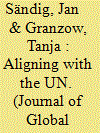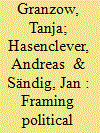|
|
|
Sort Order |
|
|
|
Items / Page
|
|
|
|
|
|
|
| Srl | Item |
| 1 |
ID:
160478


|
|
|
|
|
| Summary/Abstract |
Self-determination campaigns in the Global South have often been pursued through warfare. Since the 1990s, however, an increasing number of such movements have endorsed legalistic mechanisms of international law and the UN's core principle of nonviolence. We introduce the concept of UN-aligned self-determination movements for them. As a starting point to explain their occurrence, we examine two major cases: The Peaceful Southern Movement (Hirak) in Yemen and the Movement for the Actualization of the Sovereign State of Biafra (MASSOB) in contemporary Nigeria. Our analysis combines theories on political opportunities, diffusion, and framing from social movement, civil resistance, and armed rebellion research. We observe that since the end of the Cold War the rule of law, role of the UN, and norms of nonviolent conflict resolution have been strengthened in the international system. We argue that this has given self-determination movements in the Global South new opportunities for claims-making: Facing repressive governments, the leaders of Hirak and MASSOB have successfully aligned their movements with the UN by diffusing its core principles to the local struggle through resonant collective action frames. Thereby, our study contributes to understanding the diffusion of nonviolence in the international system, in particular in self-determination campaigns, and directs attention to the rise of UN-aligned self-determination movements.
|
|
|
|
|
|
|
|
|
|
|
|
|
|
|
|
| 2 |
ID:
144448


|
|
|
|
|
| Summary/Abstract |
The papers of the special issue analyse intra-state conflict escalation and armed rebellion from a framing perspective. Following Robert Benford and David Snow, framing is understood as strategic communication to mobilise a constituency for political action through persuasive ‘collective action frames’.1 Such collective action frames comprise the identification of common grievances and responsible actors (diagnostic frame), possible solutions to the identified problems (prognostic frame) and sufficiently strong reasons to push a constituency into political action (motivational frame). In our understanding, ‘collective action frames’ can mobilise people for various forms of contentious behaviour (including armed rebellion), but they can also fail to resonate with the audience. Thus, we expect political violence to occur only if framers make a convincing and resonant ‘call to arms’. In order to show that collective action frames indeed matter for various forms of political violence and most importantly civil war, the special issue investigates two aspects in detail: First, the contributions trace the selection and development of collective action frames (in particular those that propagate violence) and analyse the framing strategies deployed by movement leaders. Second, the authors of this special issue seek to explain why some ‘calls to arms’ resonate and make a constituency support an armed group, whereas others fail to ‘sweep the audience’.
|
|
|
|
|
|
|
|
|
|
|
|
|
|
|
|
| 3 |
ID:
144450


|
|
|
|
|
| Summary/Abstract |
Why do some protest movements erupt into rebellion, whereas others protest peacefully under similar circumstances? Addressing this question, this paper investigates the cases of Boko Haram (rebellion) and MASSOB (non-violent protest) in contemporary Nigeria. Conventional explanations of rebellion focusing on opportunity, inequality, and repression cannot explain why these movements have pursued different protest strategies. This paper tries to explain this puzzle by investigating the signifying work and meaning construction of both movements drawing on the framing approach from social movement studies. The framing analysis shows that the different protest behavior largely results from the differing cultural context of both movements, from the agency of the framers, and from successful frame alignment, which results in frame resonance and, thereby, the successful mobilization for collective action.
|
|
|
|
|
|
|
|
|
|
|
|
|
|
|
|
|
|
|
|
|